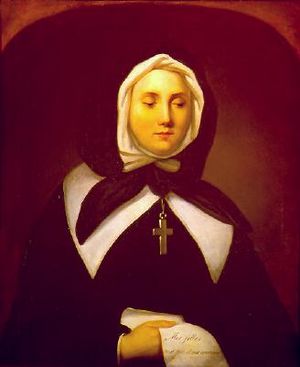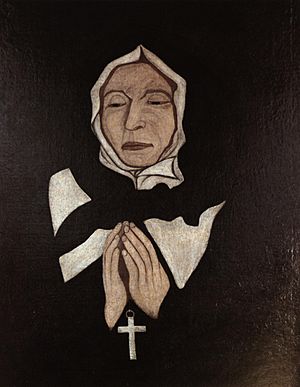Marguerite Bourgeoys facts for kids
Quick facts for kids Marguerite Bourgeoys |
|
|---|---|

Portrait by Antoine Plamondon
|
|
| Foundress of the Congregation of Notre Dame | |
| Born | 17 April 1620 Troyes, Champagne, Kingdom of France |
| Died | 12 January 1700 (aged 79) Fort Ville-Marie, New France, French Colonial Empire |
| Venerated in | Catholic Church (Canada and the United States) Anglican Church of Canada |
| Beatified | 12 November 1950 by Pope Pius XII |
| Canonized | 31 October 1982, Vatican City by Pope John Paul II |
| Major shrine | Notre-Dame-de-Bon-Secours Chapel in Montreal, Quebec, Canada |
| Feast | 12 January |
| Patronage | against poverty; loss of parents; people rejected by religious orders |
Marguerite Bourgeoys (born April 17, 1620 – died January 12, 1700) was a French woman who became a nun and started a special group of sisters called the Congregation of Notre Dame of Montreal. She founded this group in a place called New France, which is now part of Quebec, Canada.
Marguerite was born in Troyes, France. She joined a group that helped poor people outside of convents. The governor of Montreal asked her to come to New France and start a school. So, she sailed to Fort Ville-Marie (which is now Montreal) in 1653. There, she built schools and taught young girls, poor children, and children from First Nations communities. She continued this important work until just before she died in 1700.
Marguerite Bourgeoys is very important because she created one of the first religious communities in the Catholic Church where the sisters did not live shut away in a convent. She was declared "venerable" by the pope in 1878. Later, in 1982, she was made a saint by the Catholic Church. She was the first female saint from Canada.
Contents
Early life and call to teach
Marguerite Bourgeoys was born on April 17, 1620, in Troyes, France. Her parents were Abraham Bourgeoys and Guillemette Garnier. She was the seventh of their thirteen children.
When she was a girl, Marguerite wasn't very interested in joining the religious groups at the local monastery. However, she decided to join a special group called a sodality. This group was connected to the Congregation Notre-Dame. The sodality helped poor young girls who couldn't afford to live at the monastery. They taught these girls about religion and how to be good teachers.
In 1652, Paul de Chomedey, Sieur de Maisonneuve, who was the governor of the French settlement in Montreal, visited his sister in Troyes. His sister was a nun who led the sodality Marguerite belonged to. The governor invited Marguerite Bourgeoys to come to Canada and start a school in Ville-Marie (which later became the city of Montreal).
Marguerite accepted this big task to start a new religious group and a mission in New France. In February 1653, she sailed from France on a ship called the Saint-Nicholas. About 100 other people, mostly men, were also on board. They were all going to New France to work and build the colony.
Life in the new colony
Marguerite arrived in Quebec City on September 22. The Ursuline nuns there offered her a place to stay. But Marguerite chose to live with the poor settlers instead. She wanted to understand their lives. The colony was very small, so Marguerite quickly got to know almost everyone.
During these first years, Marguerite started building important places. In 1657, she organized a group of workers to build Ville-Marie's first church. It was called the Notre-Dame-de-Bonsecours Chapel. In April 1658, Governor de Maisonneuve gave her an empty stone stable. Marguerite turned this stable into a schoolhouse for her students. This was the very beginning of public schooling in Montreal. Marguerite started it just five years after she arrived.
Soon after getting the stable, Marguerite went back to France. She wanted to find more women to come to the colony and become teachers. While there, she also helped house and care for the "King's Daughters" (known as filles du roi in Quebec). These were orphan girls sent by the King of France to marry and start families in the colony. Marguerite and her four helpers also met with male settlers who came looking for wives.
Growing the Congregation
The small group of women with Marguerite began to live a religious life together. They prayed and ate meals as a community. They also worked in different villages and towns across the colony, teaching children. For three years, Marguerite and her group worked to get official approval from the King and the Church in New France.
In 1669, Marguerite met with François de Laval, who was the highest religious leader in New France. He gave the Congregation Notre-Dame permission to teach all over the island of Montreal. They could also teach anywhere else in the colony where their help was needed.
In 1670, Marguerite went back to France again. She wanted to meet the King to make sure her community would not be forced to live shut away in a convent. She left with no money or clothes. She only had a letter from Jean Talon, a royal official, who praised her great work for the colony. By May 1671, she had met with King Louis XIV. He gave her special papers called "letters patent" that protected her community. These papers said her group could be "secular Sisters," meaning they could live and teach outside of a convent. The King himself wrote that Marguerite had "given free instruction to the young girls" and had "built permanent buildings."
A time of growth
Historians call the time after 1672 the "Golden Age" for Marguerite's Congregation.
She opened a boarding school in Ville-Marie. This meant that wealthier girls didn't have to travel all the way to Quebec for their education. She also started a school in Pointe-Saint-Charles where women could learn needlework and other useful skills. Other members of her Congregation opened smaller schools in places like Lachine and Pointe-aux-Trembles. In 1678, Marguerite also started a small school for Catholic Native Americans in a mission village south of Montreal called Kahnawake. This village was mostly made up of Mohawk and other Iroquois people who had become Catholic.
In the 1680s, the group of sisters grew a lot. They finally became well-known in Quebec City. The new bishop, Jean-Baptiste De La Croix de Saint-Vallier, was very impressed with the school Marguerite had started. He worked with her to open a similar school in Quebec. Many sisters were sent to Île d'Orléans to help the growing community there. In 1692, the Congregation opened a school in Quebec specifically for girls from poor families.
Final years and legacy
Marguerite Bourgeoys announced in 1683 that she would step down from leading the Congregation. However, she remained an important figure until 1693. She stopped handling the daily tasks but worked to help her sisters keep their special spirit. Marguerite and her friends kept their "secular" way of life. This was important because Bishop Saint-Vallier tried to make them live a "cloistered" life, like nuns who stay inside a convent. On July 1, 1698, the Congregation was officially recognized as a religious community.
During her last two years, Marguerite spent most of her time praying and writing her life story. Some parts of her autobiography still exist today. She passed away in Montreal on January 12, 1700.
Becoming a saint
The day after Marguerite died, a priest wrote, "If saints were made saints by what people said, tomorrow we would be saying the Mass of Saint Marguerite of Canada." Many people admired her greatly, even before she was officially recognized as a saint.
There are many stories about the time before her death. It is said that the elderly Sister Bourgeoys offered her own life to God to save a younger nun who was very sick. After intense prayer, the young nun was cured, and Marguerite became very ill, dying soon after.
After her death, people continued to admire her. The convent held a public viewing of her body. People treasured objects that they touched to her hands, believing these items became special relics. Her body was kept by the church in Ville-Marie. However, her heart was removed and kept as a special relic by the Congregation.
Marguerite Bourgeoys was made a saint by the Catholic Church in 1982. She is known as the first female saint from Canada. The process to make her a saint began almost 100 years earlier, in 1878. That's when Pope Leo XIII gave her the title of "venerable." In November 1950, Pope Pius XII beatified her, giving her the title "Blessed Marguerite Bourgeoys." Two miracles were needed for her beatification. Both involved people being miraculously cured from a serious foot infection called gangrene. These cures happened to Joseph Descoteaux and John Ludger Lacroix. On April 2, 1982, Pope John Paul II officially recognized another miracle linked to her prayers. On October 31 of that year, she was officially made Saint Marguerite Bourgeoys.
Honors and recognition
On May 30, 1975, Canada Post released a special stamp called 'Marguerite Bourgeoys, 1620-1700'. It was designed by Jacques Roy and based on a painting by Elmina Lachance.
See also
 In Spanish: Margarita Bourgeoys para niños
In Spanish: Margarita Bourgeoys para niños


